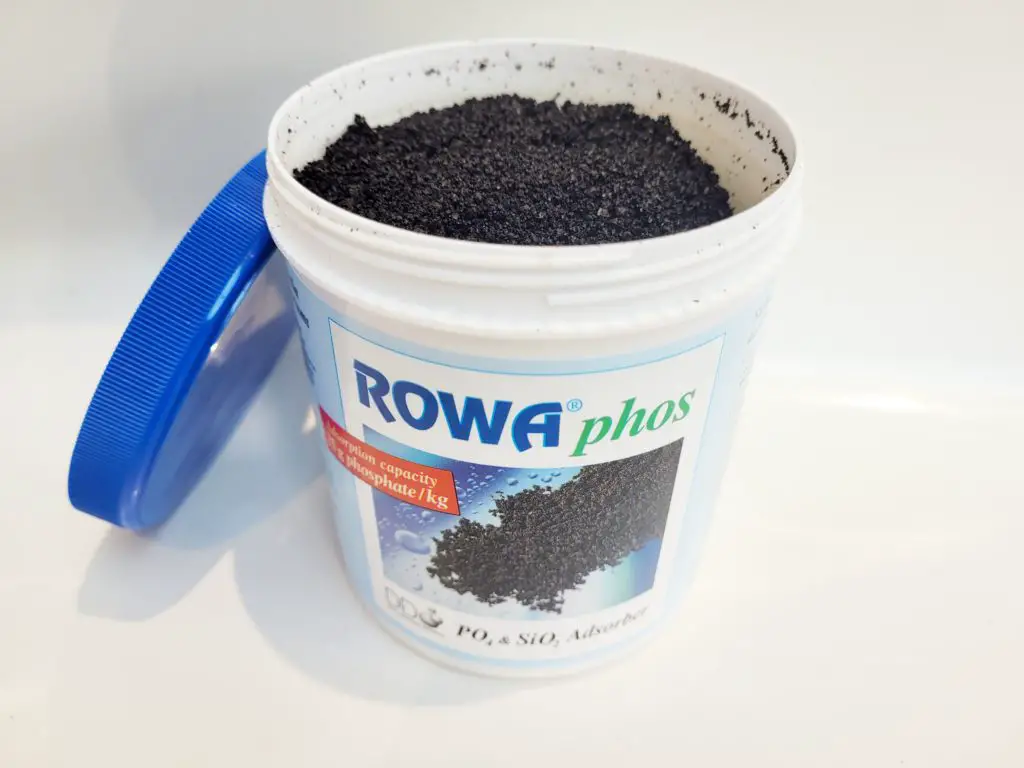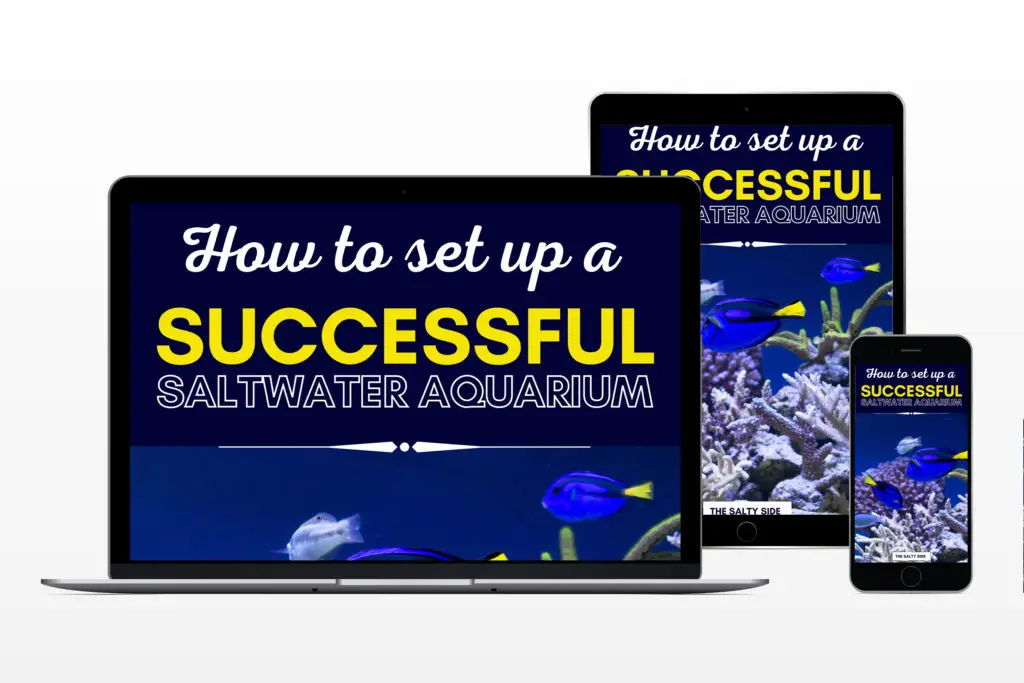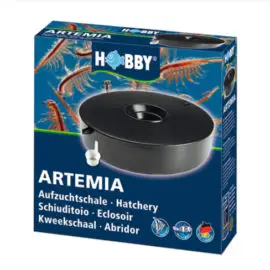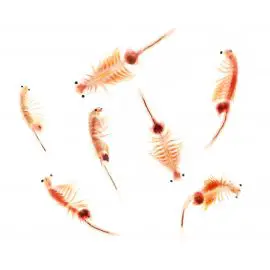How to Use ROWAphos in a Saltwater Tank

ROWAphos is one of those products I wish I did not have to use, but it works so well that most reefers end up using it, or trying it at least. It is very effective at maintaining lower levels of phosphate in any reef tank, provided the instructions are followed. Having used it for years, the process of changing out an old batch for a new batch has become a well-honed process. In this article I will share with you how to use ROWAphos in a saltwater aquarium.
How to use ROWAphos without a reactor
The first time most reefers use ROWAphos is without a reactor, this being the cheaper option. You can place it in a fine-weave media bag. If you have bought the 100ml or 250ml pots, the appropriate bags are included. Once the media bag has been filled with the correct amount of ROWAphos, you will need to rinse it through with RO water, or old tank water. This will get rid of the dust that is evident in a brown-red runoff. Rinse until the water is clear before placing it in your tank. ROWAphos has a tendency to clump, especially if using Kalkwasser. It is a good idea to prevent clumping by disturbing the bag every now and again.
- Best Selling Phosphate Remover
- Used Widely all over the world
- Largest absorption ability
Where do I put ROWAphos in a saltwater tank?
ROWAphos, when in a media bag, is best placed in a fast flow area in your filter or sump. Some hobbyists place the bag in the weir. This will get the best out of ROWAphos in a media bag, but limits the potential because water cannot run through the media freely.
How to use ROWAphos in a reactor
To get the most out of ROWAphos most reefers turn to using it in a fluidized reactor. Reactor is the fancy name for a Perspex tube with an inlet and an outlet. This allows the water to pass through the ROWAphos, keeping it fluidised (semi-suspended) in the reactor.
Choose your brand of reactor first. I have been using a TFL Phosban Reactor 150 for years. If it does not have a pump included, a 200gph pump would be a good choice. Although this pump is slightly overpowered for the job, ROWAphos can sometimes become clumped at the bottom of the reactor. Opening the valve and allowing more water through re-fluidizes the media.
If your reactor includes a sponge on the bottom, remove this. ROWAphos is made of very fine particles that will become lodged in the sponge. This will stop the fluidised process.
Add the required amount of ROWAphos into the reactor, and fill up the remainder with tank water. Secure the upper section and sponge, before turning the lid closed. You will notice the water in the reactor turn very brown.
Place the reactor in a suitable place in your sump. The TLF Phosban reactor includes a lip to hang the reactor on a glass edge.
Connect the pump tubing to the central inlet. The reactor uses ½” tubing.
Most reactors include a flow valve. Connect the flow valve to the length of tubing to be used for the outlet. Open the valve half way.
Place a small bucket in front of the sump and direct the outlet hose into the bucket.
Turn on the pump.
Watch as the dusty effluent runs into the bucket, turning from dark red-brown to clear. This will use no more than 1 gallon of tank water. Keep an eye on the media to make sure the flow is not too strong. You do not want the ROWAphos ending up in the bucket too.
Turn the flow off, and redirect the tubing into the sump.
Replace the tank water used to flush out the ROWAphos with freshly mixed salt water.
Turn the pump back on and watch the media in the reactor. Adjust the flow valve to ensure the ROWAphos is NOT tumbling. It should be gently bubbling or undulating.
- Capacity: Use with up to a maximum of 200 grams (385 ml) of PhosBan, or a media height of 5 inches (13 cm)
- Aquarium size: One reactor for up to 150 gallons (568 Liters). Multiple reactors may be used for larger aquariums.
- Recommended flow rate: ca. 20 - 30 gal/hr (75 - 115 l/hr) . Too much flow can grind PhosBan
How much ROWAphos should I use?
ROWAphos should be used at a rate of 100g per 100 gallons (400L) for saltwater, and has the capacity to export 3ppm of phosphate before it needs to be replaced. If you are using ROWAphos for the first time, or you have let phosphate get higher than it should be, you will find that you may need to replace the media a few times to regain control.
Do I need to rinse ROWAphos?
As described above, it is better to rinse ROWAphos before using it either in a media bag or in a reactor. Although it is non-toxic, failing to rinse will result in your water turning a shade of brown. This may be accompanied by a light brown film that you will need to clean from your glass too.
Just starting out in the hobby?
Get your copy of How To Set Up A Successful Saltwater Aquarium ebook today.
This ebook will help to guide you past the mistakes I have made over the years.
How long does it take ROWAphos in a saltwater tank to work?
ROWAphos is extremely effective. It will start working immediately. However, you may not see the results in the first instance. If this is the first time you have used a phosphate remover, or you have allowed phosphate to build up in your tank, then repeated replacement of media may be required. I have experienced this myself. I allowed my phosphate to climb to 0.1ppm to see if it has any effect on my coral colour. In the process, phosphate became bound to my rocks. When I turned the reactor back on again and tested for phosphate, it remained at the higher reading. I had to replace the ROWAphos every three days before I noticed a reduction.
Once phosphate has been drawn from the rocks, and is stable between 0.02ppm and 0.05ppm (the ideal range to keep algae away), then you should only need to replace ROWAphos every 4 to 6 weeks. I aim four every 4 weeks. Test regularly to find your happy medium, and replace the ROWAphos as required for your tank.
- The phosphate test kit will detect lower concentrations of phosphates
- The phosphate test is highly reliable and accurate
- The phosphate test kit includes a professional colorimetric comparator
When Should I replace ROWAphos?
Phosphate control in any tank is determined by a number of factors. Assuming you do not have phosphate bound to your rocks (as described above), you may only need to replace ROWAphos every month. However, this can only be determined by testing your water. If you are a heavy feeder, or if you should be cleaning your filter socks more regularly, you may need to replace it more often. On the other hand, if you maintain a super clean tank, your ROWAphos could last a couple of months.
How effective is ROWAphos in a saltwater tank?
ROWAphos is extremely effective in maintaining lower phosphate levels provided you are replacing it with the intention of maintaining phosphate at your chosen level. I always aim for 0.03ppm. By using ROWAphos at all times you are allowing trace amounts through that can be utilised by corals and other inhabitants of your aquarium, but limiting the ability of unwanted algae to take hold.
Can you use too much ROWAphos?
Using too much ROWAphos can have the adverse effect of stripping your tank of phosphate far too quickly. This will result in a temporary drop in pH, and a lack of trace phosphate for your corals. By stripping phosphates to zero you are unintentionally inviting unwanted dinoflagellates to proliferate, and making your corals very unhappy. To ensure this does not happen, follow the guidelines on the pot and keep it to a rate of 100g per 100 gallons (400L).
Can I put ROWAphos and carbon in the same reactor?
In theory, this is possible. ROWAphos and carbon can gently tumble together. However, carbon generally requires a much faster flow through to be thoroughly effective. By adding them together, you are minimising the impact carbon makes on a system. Additionally, ROWAphos could outlast carbon, which may become exhausted sooner. This would mean prematurely discarding ROWAphos before you need to do so.
Does ROWAphos remove silicates?
ROWAphos was never initially intended for use in aquariums. It was developed in Germany for use in the water mains. It is very effective at removing phosphates, arsenic and silicates from salt water. For this reason, ROWAphos is an effective means of ridding your tank of diatoms that feed on silicates. However, if you are treating your tank specifically with Sodium Silicate to get rid of dinoflagellates, then ROWAphos may counteract that treatment.
What are the alternatives to ROWAphos in a saltwater tank?
As effective as ROWAphos is, it may not be working for you. You could look at Seachem Phosguard or Brightwell Aquatics Phosphat-E.
Seachem Phosguard is cleaner to use, comprising of Aluminum oxide beads. It will remove both phosphate and silicates.
Brightwell Aquatics Phosphat-E is a liquid phosphate remover made from Lanthanum chloride. This is known to be very effective, to the point that caution must be used when dosing.
For more information on other phosphate removers, read this article.
Is ROWAphos a GFO?
ROWAphos is a manmade ferric oxide material engineered for the removal phosphates, arsenic and silicates. ROWA state that ROWAphos is not that same as aluminium oxide (which is visually evident) or other iron based products that claim to be the same – Granular Ferric Oxides in other words.
Reading between the lines, ROWAphos is a GFO, but engineered to be more capable than other brands. This was proven by a series of tests carried out by the Berlin Technical University. Other phosphate removers reached only 30% to 40% of removal capacity by weight, while ROWAphos performed better.
For more information on GFO’s, read this article.
Can I use NOPOX with ROWAphos?
Although Red Sea will have you believe that NOPOX should only be used on its on, many reefers combine phosphate removers with NOPOX or other forms of carbon dosing. It is completely safe to use ROWAphos together with NOPOX. In my experience, NOPOX is very good at controlling nitrates, but not so great with phosphates. Ensure, as always, that you test regularly to monitor phosphate levels so that they do not slip below 0.02ppm.

Hi, my name is Craig.
I am the owner of The Salty Side.
Firstly, thank you for visiting us. If you have found this article to be informative, and you now have a better understanding of the topic, then my job is done.
If you are feeling charitable, and feel I deserve a little thank you, I thank you in advance for any support given.







